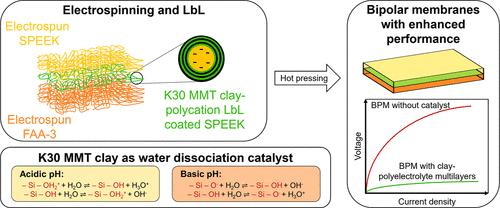利用逐层组装的粘土复合结增强双极膜的水解离能力
IF 3.9
2区 化学
Q2 CHEMISTRY, MULTIDISCIPLINARY
引用次数: 0
摘要
本研究制备了在磺化聚醚醚酮(SPEEK)电纺丝载体上涂覆逐层(LbL)组装蒙脱石(K30 MMT)粘土-聚电解质(PE)复合结的双极性膜(BPM),并对其进行了表征和水解离性能分析。重点分析了作为水解离催化剂的 K30 MMT 粘土的存在、双层层数(三层、六层和九层)以及聚乙烯强度(弱聚乙烯的聚乙烯亚胺 (PEI) 和强聚乙烯的聚二烯丙基二甲基氯化铵 (PDADMAC))对 BPM 性能的影响。BPM 由 SPEEK 和 Fumion FAA-3 聚合物通过电纺丝和热压制备而成。在 BPM 交界处加入复合多层膜后,性能最佳的改性 BPM 在反向偏压下的膜面积电阻从 560 欧姆/平方厘米降至 21 欧姆/平方厘米。双层膜的数量对整体膜电阻的影响有限,而 PDADMAC BPM 的性能优于 PEI BPM,这是因为 PE 和粘土的吸附量更高、更稳定。电化学阻抗谱显示,随着双层膜数量的增加,耗竭层厚度呈指数级下降,因为水解离反应对交界电场的依赖性降低。此外,与不含催化剂的 BPM 相比,改性交界处更高的唐南排阻将 BPM 的过选择性提高了 3 倍。总之,与不含催化剂的 BPM 相比,当使用带有复合 LBL 结的 BPM 时,这些改进可使 BPM 电渗析产生酸和碱所需的能量降低 6.7 倍。因此,在 BPM 连接中添加 MMT 粘土复合 LbL 催化剂是一种很有前途的方法,可以提高依赖 BPM 的电化学过程的效率并降低能耗。本文章由计算机程序翻译,如有差异,请以英文原文为准。

Using Layer-by-layer Assembled Clay Composite Junctions to Enhance the Water Dissociation in Bipolar Membranes
Bipolar membranes (BPMs) with a layer-by-layer (LbL) assembled montmorillonite (K30 MMT) clay-polyelectrolyte (PE) composite junction coated onto a sulfonated poly(ether ether ketone (SPEEK)) electrospun support are prepared, characterized and their water dissociation performance is analyzed. In particular, the focus is on the effect of the presence of the K30 MMT clay as a catalyst for water dissociation, the bilayer number (three, six, and nine), and the PE strength (poly(ethylenimine) (PEI) as a weak PE and poly(diallyl dimethylammonium chloride) (PDADMAC) as a strong PE) on the BPM performance. The BPMs are prepared by electrospinning and hot pressing SPEEK and the Fumion FAA-3 polymer. Adding the composite multilayers in the BPM junction decreases the membrane area resistance in reverse bias from 560 to 21 Ohms cm2 for the best-performing modified BPM. The bilayer number has limited influence on the overall membrane resistance, while the PDADMAC BPMs outperform the PEI BPMs due to the higher and more stable PE and clay adsorptions. Electrochemical impedance spectroscopy shows that the depletion layer thickness decreases exponentially with the number of bilayers as the water dissociation reaction becomes less dependent on the junction electric field. Furthermore, the higher Donnan exclusion at the modified junctions improves the BPM permselectivity 3-fold compared to the BPM containing no catalyst. Altogether, these improvements lead to 6.7 times less energy being used in BPM electrodialysis for the production of acid and base when a BPM with composite LBL junction is used compared to a BPM without catalyst. Thus, adding MMT clay composite LbL catalyst to BPM junctions is a promising method to improve the efficiency and reduce the energy consumption of electrochemical processes that rely on BPMs.
求助全文
通过发布文献求助,成功后即可免费获取论文全文。
去求助
来源期刊

Langmuir
化学-材料科学:综合
CiteScore
6.50
自引率
10.30%
发文量
1464
审稿时长
2.1 months
期刊介绍:
Langmuir is an interdisciplinary journal publishing articles in the following subject categories:
Colloids: surfactants and self-assembly, dispersions, emulsions, foams
Interfaces: adsorption, reactions, films, forces
Biological Interfaces: biocolloids, biomolecular and biomimetic materials
Materials: nano- and mesostructured materials, polymers, gels, liquid crystals
Electrochemistry: interfacial charge transfer, charge transport, electrocatalysis, electrokinetic phenomena, bioelectrochemistry
Devices and Applications: sensors, fluidics, patterning, catalysis, photonic crystals
However, when high-impact, original work is submitted that does not fit within the above categories, decisions to accept or decline such papers will be based on one criteria: What Would Irving Do?
Langmuir ranks #2 in citations out of 136 journals in the category of Physical Chemistry with 113,157 total citations. The journal received an Impact Factor of 4.384*.
This journal is also indexed in the categories of Materials Science (ranked #1) and Multidisciplinary Chemistry (ranked #5).
 求助内容:
求助内容: 应助结果提醒方式:
应助结果提醒方式:


